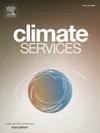将天气和气候信息服务(WCIS)与气候智慧型农业(CSA)实践联系起来
IF 4
3区 环境科学与生态学
Q2 ENVIRONMENTAL SCIENCES
引用次数: 0
摘要
本研究综合了天气和气候信息服务(WCIS)与气候智慧型农业(CSA)实践之间联系的现有知识。具体而言,它解决了以下问题:(1)全球南方,特别是非洲大陆对WCIS和CSA的了解现状如何?(2) WCIS是否有效地与CSA实践和技术相结合,以改善小农的农业用水管理(AWM) ?(3)将WCIS和CSA联系起来如何促进区域差异化和特定环境的气候适宜技术和政策的识别、评估和优先排序,以加强各个层面(田间、农场、方案和流域)的农业用水管理?方法本研究采用系统和荟萃分析方案首选报告项目(PRISMA-P)指南。它包括在Scopus和Web of Science数据库中搜索同行评议的文章、书籍和关注南半球的灰色文献。结果表明,季节性预报是农民可获得的主要WCIS,他们主要利用季节性预报来规划灌溉和集水活动。每日预报与灌溉等做法有关。研究还表明,温度和降雨量(数量和分布)主要通过推广服务传播给农民。农民使用的主要CSA实践是碳智能(例如,堆肥),水智能实践(改良品种,灌溉,RWH),天气智能实践(IPM &;作物保险)和氮肥智能实践(有机肥、作物多样化)。碳智能实践咨询通常与降雨开始和结束的信息密切相关,而水智能实践则与降雨开始、降雨季节结束和降雨强度相吻合。天气智能实践与干旱、温度和降雨分布密切相关,而氮智能实践与降雨结束和温度有关。结论WCIS与不同类型的CSA存在明显的相关性。该研究认为,增加对WCIS的访问可以促进CSA实践的采用和扩展。本文章由计算机程序翻译,如有差异,请以英文原文为准。
Linking weather and climate information services (WCIS) to Climate-Smart Agriculture (CSA) practices
Objective(s)
This study synthesises existing knowledge on the linkages between Weather and Climate Information Services (WCIS) and Climate-Smart Agriculture (CSA) practices. Specifically, it addresses the following questions: (1) What is the current status of knowledge on WCIS and CSA in the global south, specifically the African continent?, (2) Are WCIS effectively tailored and linked to CSA practices and technologies to improve agricultural water management (AWM) amongst smallholder farmers?, and (3) How can linking WCIS and CSA facilitate the identification, appraisal and prioritization of regionally differentiated and context-specific climate-appropriate technologies and policies that enhance agricultural water management at various levels (field, farm, scheme, and catchment)?
Methods
The study used the Preferred Reporting Items for Systematic and Meta-Analysis Protocol (PRISMA-P) guidelines. It involved the search of the Scopus and Web of Science databases for peer-reviewed articles, books, and grey literature focussed on the global south.
Results
The results revealed that seasonal forecasts were the main WCIS available to farmers who utilised them to plan predominantly for irrigation and water harvesting activities. Daily forecasts were linked to practices such as irrigation. The study also revealed that temperature and rainfall (amount and distribution) were predominantly disseminated to farmers through extension services. The dominant CSA practices used by farmers were carbon-smart (e.g., composting), water-smart practices (improved varieties, irrigation, RWH), weather-smart practices (IPM & crop insurance), and nitrogen-smart practices (organic fertiliser, crop diversification). Advisories on carbon-smart practices generally aligned closely with the start and end of rainfall information, while the water-smart practices were corroborated with the rainfall onset, end of rainfall season, and rainfall intensity. Weather smart practices were strongly linked to drought, temperature, and rainfall distribution, whereas nitrogen smart practices were linked with the end of rainfall and temperature.
Conclusions
The study concluded that distinct linkages exist between WCIS and various CSA categories. The study argues that increasing access to WCIS can facilitate the adoption and scaling of CSA practices.
求助全文
通过发布文献求助,成功后即可免费获取论文全文。
去求助
来源期刊

Climate Services
Multiple-
CiteScore
5.30
自引率
15.60%
发文量
62
期刊介绍:
The journal Climate Services publishes research with a focus on science-based and user-specific climate information underpinning climate services, ultimately to assist society to adapt to climate change. Climate Services brings science and practice closer together. The journal addresses both researchers in the field of climate service research, and stakeholders and practitioners interested in or already applying climate services. It serves as a means of communication, dialogue and exchange between researchers and stakeholders. Climate services pioneers novel research areas that directly refer to how climate information can be applied in methodologies and tools for adaptation to climate change. It publishes best practice examples, case studies as well as theories, methods and data analysis with a clear connection to climate services. The focus of the published work is often multi-disciplinary, case-specific, tailored to specific sectors and strongly application-oriented. To offer a suitable outlet for such studies, Climate Services journal introduced a new section in the research article type. The research article contains a classical scientific part as well as a section with easily understandable practical implications for policy makers and practitioners. The journal''s focus is on the use and usability of climate information for adaptation purposes underpinning climate services.
 求助内容:
求助内容: 应助结果提醒方式:
应助结果提醒方式:


